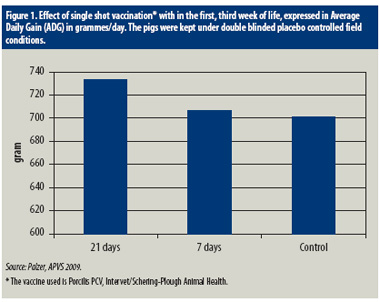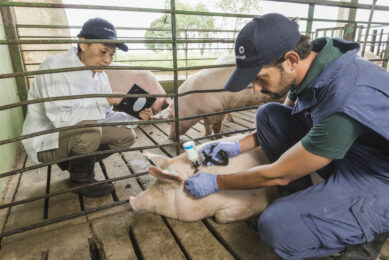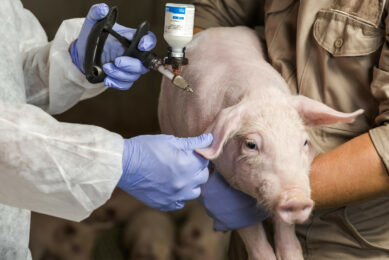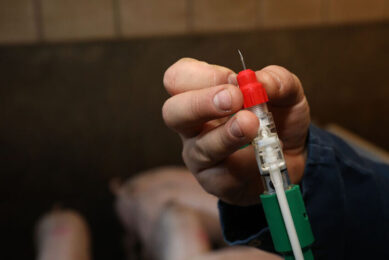Why viraemia matters: The PCV2 debate continues

Until PCV2 piglet vaccines entered the market, the detection of Porcine Circovirus 2 (PCV2) viral material by the quantitative Polymerase Chain Reaction (qPCR) method had always been subject of skepticism. This is because PCV2 can be detected both in apparently healthy and in infected animals. What does this PCV2 material actually say?
By Alex A.S. Eggen, Intervet/Schering-Plough Animal Health, Boxmeer, the Netherlands
©
When piglet vaccines for PCV2 entered the market, first of all in Canada, it was quickly recognised that the level of PCV2 viraemia can be reduced. This reduction had an enormous impact on the pigs’ well-being and on their performance. It also became clear that different vaccines vary in their efficiency of reducing PCV2 viraemia. So now the debate centers on the importance of the PCV2 viraemia levels, as these are still apparent under field conditions after vaccination.
©
The discussion will be continued in the country in which the value of these piglet vaccines was first acknowledged, as Vancouver, Canada is the venue for the biannual congress of the International Pig Veterinary Society Congress, in July 2010. New data from both research and the field will be presented at this world congress for swine veterinarians.
©
The majority of the abstracts submitted to the scientific committee will undoubtedly focus on PCV2 virus. The debate will center on the influence of Maternally Derived Antibodies (MDA) at the time of vaccination, on the efficiency of vaccination, and on the impact of PCV2 viraemia on performance. It is well accepted by all stakeholders in the industry that viraemia can still occur when vaccinated animals are challenged in the field with PCV2 virus.
©
In this report, these two important aspects will be discussed separately, and the conclusion will focus on the relationship between them. What has become clearer, however, is that controlling PCV2 viraemia in piglets is key in optimising their performance.
©
Effect of MDA
The manufacturers’ leaflets for the currently available PCV2 vaccines contain information about the impact of MDA on vaccine efficacy, and the text is different for each of them. But what are the findings of independent researchers?
©
Dr Maria Fort, CreSA, Barcelona, reported in the last two years that Porcilis PCV, a PCV2 vaccine manufactured and marketed by Intervet/Schering-Plough Animal Health, induces high levels of virus neutralising (VN) antibodies, and also a pronounced cellular immune response.
©
In addition, Prof Dr Paolo Martelli, Parma University, Italy, has confirmed this and all researchers agree that VN antibodies are the first line of defense. They neutralise the virus, making it impossible for the PCV2 virus to enter the cells, and it is inside the cells where the PCV2 virus causes the main damage. Fort also observed that a certain level of antibodies is required to neutralise the virus effectively. A piglet with an antibody titre below that level will experience viraemia when challenged, both under laboratory and field conditions. PCV2 vaccination needs to induce antibodies in excess of the level described by Fort and this level should be maintained for the whole length of the fattening period.
©
Field trials
In 2009, at the Asian Pig Veterinary Society Congress, held in Tsukuba, Japan, Andreas Palzer reported a field trial in which piglets were vaccinated with a single dose of 2 ml of the vaccine either very young, during the first week of life, or at three weeks of age.
©
Since MDA levels decline naturally over time, the pigs vaccinated later (at three weeks of age) have lower MDA levels than those vaccinated at one week of age. The two groups were kept under exactly the same conditions, but not only did they have different serological profiles, they also performed differently. The group vaccinated at three weeks (with lower MDA levels) responded better to the vaccine and they produced a higher level of antibodies as a reaction to vaccination which were present when they experienced the field challenge. This group also performed significantly better in average daily gain, by 27 g/day (p=0.00416). The group vaccinated in the first week of life performed better than the unvaccinated controls, showing that even in the presence of high levels of MDA, vaccination can still be worthwhile (see Figure 1). However, for the same input of time and labour, vaccinating at three weeks of age yields a higher return on investment (ROI).
©
It should be noted that even though MDA levels at vaccination are different between litters of different sows farrowing at the same time, the vaccine produces uniform antibody titres. And finally, it should not be forgotten that MDA titres are higher at the moment than they used to be some years ago. Concluding and summarising many different publications: virus neutralising antibodies are the first line of defense against a challenge. Above a certain level these antibodies are protective. For optimal efficacy, these VN antibodies need to be induced and remain above a certain level for the whole length of the growing-finishing phase. Antibodies below the protective level will result in suboptimal performance following a PCV2 field infection, especially in the finishing phase.
©
Why viraemia matters
Different publications have described the relationship between the quantity of PCV2 virus, determined by qPCR, and the different manifestations of PCVAD. However, as already noted, it is not possible to reproduce PCVAD under laboratory conditions. Therefore, very detailed monitoring of a field infection is needed if conclusions are to be drawn on the impact PCV2 viraemia on the performance of piglets in the field. For the IPVS Congress in Vancouver, 2010, several abstracts have been submitted dealing with this subject. Melissa Reindl will report on a comparative study between two vaccines, demonstrating the difference in Average Daily Gain (ADG) in relation to different levels of PCV2 viraemia (see Figure 2).
©
Cate Dewey, Guelph University, will explain in an oral presentation that controlling viraemia is key to obtaining optimal vaccine efficiency. Furthermore, the Department of Animal Heath of the University of Parma, headed by Prof Paolo Martelli, has studied the performance of the vaccine in depth, in relation to the control of clinical signs, reduction in viraemia and improvement in ADG, confirming the Guelph findings.
©
Cellular immune response was also measured in a field study in Italy by Parma University (Martelli c.s.), and the results supported Fort’s findings. The absence of a cellular immune response after a field challenge in vaccinated groups is a clear indication of the quantity and quality of VN antibodies. The virus is neutralised by these antibodies before it reaches the cells, therefore no cellular immunity will be induced in these vaccinated pigs which are, as a consequence of the VN antibodies, very well protected.
©
This also explains the absence of viraemia. A virus needs a cell in which to multiply. Viraemia will only occur after this intracellular virus multiplication. So when the virus is neutralised by the VN antibodies before it can enter the cell, no viraemia can take place. The higher the VN antibody level at the time of the PCV2 challenge, the better the protection against viraemia, and the better the pigs’ performance in economic terms.
©
PCVAD is still a multi-factorial disease. PCV2 virus is required together with another factor to cause disease. The presence of PCV2 virus (viraemia) puts the pigs at risk for any other factor to induce economic damage. Vice versa, the absence of PCV2 virus in vaccinated pigs after a PCV2 field virus challenge is the best guarantee for optimal performance of these pigs.
©
Conclusion
A potent vaccine is needed to overcome the levels of MDA at the moment of vaccination encountered under field conditions. Vaccination in the presence of MDA needs to induce antibodies above protective levels, as postulated by Maria Fort, for the duration of the finishing period. This strategy gives the best guarantee for the best protection against viraemia, and that means improved performance. The message from the field and the research data is quite clear: PCV2 viraemia matters to pigs, for swine veterinarians and producers alike.
©
References available on request.
©
Source: Pig Progress magazine Volume 26. 5











